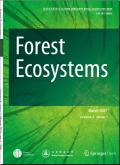Spatio-temporal dynamics of future aboveground carbon stocks in natural forests of China
IF 3.8
1区 农林科学
Q1 FORESTRY
引用次数: 0
Abstract
Natural forests are the primary carbon sinks within terrestrial ecosystems, playing a crucial role in mitigating global climate change. China has successfully restored its natural forest area through extensive protective measures. However, the aboveground carbon (AGC) stock potential of China's natural forests remains considerably uncertain in spatial and temporal dynamics. In this study, we provide a spatially detailed estimation of the maximum AGC stock potential for China's natural forests by integrating high-resolution multi-source remote sensing and field survey data. The analysis reveals that China's natural forests could sequester up to 9.88 ± 0.10 Pg C by 2030, potentially increasing to 10.46 ± 0.11 Pg C by 2060. Despite this, the AGC sequestration rate would decline from 0.19 ± 0.001 to 0.08 ± 0.001 Pg C·yr−1 over the period. Spatially, the future AGC accumulation rates exhibit marked heterogeneity. The warm temperate deciduous broadleaf forest region with predominantly young natural forests, is expected to exhibit the most significant increase of 26.36% by 2060, while the Qinghai-Tibet Plateau Alpine region comprising mainly mature natural forests would exhibit only a 0.74% increase. To sustain the high carbon sequestration capacity of China's natural forests, it is essential to prioritize protecting mature forests alongside preserving and restoring young natural forest areas.
中国天然林未来地上碳储量的时空动态
天然林是陆地生态系统内的主要碳汇,在减缓全球气候变化方面发挥着至关重要的作用。中国通过广泛的保护措施,成功恢复了天然林面积。然而,中国天然林的地上碳储量潜力在时空动态上仍存在较大的不确定性。本文通过综合高分辨率多源遥感和野外调查数据,对中国天然林最大AGC储量潜力进行了空间精细估算。分析显示,到2030年,中国天然林可封存高达9.88±0.10 Pg C,到2060年可能增加到10.46±0.11 Pg C。尽管如此,在此期间,AGC固存率将从0.19±0.001 Pg C·yr - 1下降到0.08±0.001 Pg C·yr - 1。在空间上,未来AGC积累速率表现出明显的异质性。到2060年,以幼龄天然林为主的暖温带落叶阔叶林区预计将增加26.36%,而以成熟天然林为主的青藏高原高寒区仅增加0.74%。为了保持中国天然林的高固碳能力,必须在保护和恢复年轻天然林的同时,优先保护成熟森林。
本文章由计算机程序翻译,如有差异,请以英文原文为准。
求助全文
约1分钟内获得全文
求助全文
来源期刊

Forest Ecosystems
Environmental Science-Nature and Landscape Conservation
CiteScore
7.10
自引率
4.90%
发文量
1115
审稿时长
22 days
期刊介绍:
Forest Ecosystems is an open access, peer-reviewed journal publishing scientific communications from any discipline that can provide interesting contributions about the structure and dynamics of "natural" and "domesticated" forest ecosystems, and their services to people. The journal welcomes innovative science as well as application oriented work that will enhance understanding of woody plant communities. Very specific studies are welcome if they are part of a thematic series that provides some holistic perspective that is of general interest.
 求助内容:
求助内容: 应助结果提醒方式:
应助结果提醒方式:


